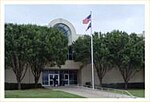Pipeline Express
Former roller coasters in TexasRemoved roller coastersRoller coasters introduced in 1992Roller coasters manufactured by other buildersRoller coasters that closed in 1992 ... and 1 more
Steel roller coasters
Pipeline Express was a steel roller coaster located at Boardwalk Fun Park in Grand Prairie, Texas. When built in 1992, the coaster was the newest Auto Sled model from Bailey Manufacturing of Cameron, Ontario. The five sleds could hold one rider each. In September 1992, an accident on the coaster threw a 12-year-old girl some 35 feet (11 m) into an unused pool beneath it causing her to slip into a coma and suffer brain trauma. It was closed following the accident. The girl's parents sued the park for negligence and deceptive trade practices.The coaster never reopened and remained standing until 1997, when it was demolished along with the rest of the park.
Excerpt from the Wikipedia article Pipeline Express (License: CC BY-SA 3.0, Authors).Pipeline Express
East Palace Parkway, Grand Prairie
Geographical coordinates (GPS) Address Nearby Places Show on map
Geographical coordinates (GPS)
| Latitude | Longitude |
|---|---|
| N 32.761 ° | E -96.997 ° |
Address
East Palace Parkway
75050 Grand Prairie
Texas, United States
Open on Google Maps




